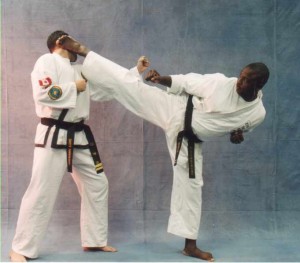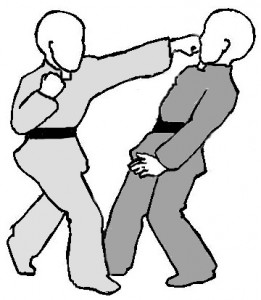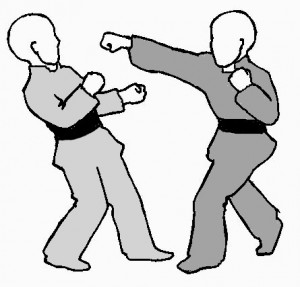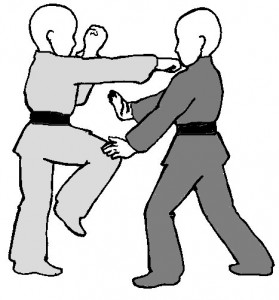 Fight Smart!
Fight Smart!
Ancient Chinese Strategies Can Bring Victory In The Sparring Ring
By Stefan Verstappen,
Originally published in Black Belt Magazine Jan 2000
When martial artists train in sparring the emphasis is usually on how to become stronger and faster than your opponent but there are two drawbacks to relying on this type of training.
First, as we have all been told, there will always be someone else stronger and faster. Second, even if you do become the fastest and strongest it can only last a short time. Every athlete knows that, while it is possible to train for a peak performance, it is impossible to consistently perform at your highest level. That means that all the hard work and sweat spent doing speed and strength drills only provides a few weeks worth of combat advantage. While speed and strength training improves overall fitness and can be timed to peak in time for the annual school tournament, it’s just too small of a gain to be relied on exclusively.
To improve one’s chances of success in any form of combat one would need some advantage other than force alone. Military history shows that battles are often won not by the biggest or fastest army, but by the commander who has the best strategy. The sparring arena is no different from the battleground. A slower and weaker fighter can beat a faster and stronger fighter if he is adept at using strategy.
The following three strategies come from The Thirty-Six Strategies. Although little known in the west, the Thirty Six Strategies are popular in China and Japan and are studied by both the military and political elite. Ancient in origin, the author or originators are unknown while the stratagems themselves have long been a part of China’s common folklore.
Use the same feint twice. Having reacted to the first and often the second as well, the enemy will be hesitant to react to a third feint. Therefore, the third feint is the actual attack catching your enemy with his guard down.
This is one of the first strategies fighters learn as they gain experience since it is easy to execute and often quite effective. This strategy involves sending false signals to create an expectation in your opponent and then changing tactics suddenly. By knowing what your opponent expects, and thus what his reaction will be, you can attack his opening. As the 16th century Japanese sword master Musashi once wrote, “If the enemy expects fire give him rain.” For example. Most novice fighters will routinely launch a kicking technique first, to close the distance, followed by a hand technique to score. During tournaments you can see this same combination repeated over and over without any fighter catching on and changing tactics.
The typical combo is front snap kick aimed mid-level, followed by a jab and reverse punch. This is done so often that the first reaction of most defenders is to drop their hands in anticipation of a kick to the mid-section. The key to working this strategy takes advantage of just such an expectation. Launch your first and second attacks using an identical pattern; a mid-level kick followed by a high level hand technique. The defender learns to block low first and then high. On your third attack you reverse the order, attack high with a hand technique and finish with a low kick. Since the opponent’s nervous system is geared to react with a low block first, when you begin to move, his hands will start to drop leaving his head open. By the time he realize the attack is coming in high it is too late to reverse direction. (Since all this takes place in approximate .5 seconds).
Even if the opponent is able step out of range of the high attack he will almost always raise his hands in reaction to the initial attack leaving his midsection undefended against the follow-up leg attack. At best you score two hits, at worst the kick will still score. There are endless variations on this strategy and each student is encouraged to perfect one or two combinations until they feel natural.

Lure the Tiger Down the Mountain
Never directly attack a well entrenched opponent. Instead lure him away from his stronghold and separate him from his source of strength.
When faced with a fighter who sits back in a defensive position waiting for you to attack be careful not to. Taking a defensive position, if one is good, provides a definite advantage. An opponent always exposes a target when attacking and an observant defensive fighter can hit that target before the attacker is within position to do damage. For example, when in a defensive position waiting for an attack, one of the best techniques is to launch a mid-level kick with your lead leg as the opponent closes the distance. If leading with a hand technique most attackers will walk right into the kick adding their own momentum to the impact. If the attacker is leading with a kick then usually the leg is jammed and/or he his pushed off his feet (or foot since his other leg would still be in the air at this point). This defense strategy is really difficult to penetrate and so one must entice the opponent into action by showing a glaring weakness in your false attack. Then when you launch your true attack you know where the counter strike is going to hit.
One tactic is to first indicate through body language a preference for a jab and lunging reverse punch combination. Execute this a couple times from a safe distance while keeping the hands and arms up high exposing your ribs and abdomen. The defensive fighter will see in this a perfect opportunity to direct a kick to your midsection the next time you move in. However, the true attack starts off like a jab but the lead hand sweeps down suddenly into a low block knocking the anticipated counter-kick out of the way. The reverse punch follows in close order catching the opponent with his arms down mid-kick. ( Since dropping the hands during a kick is such a common flaw.) One of the reasons this tactic works so well is that few fighters would expect you to begin an attack with a block!
 Await the Exhausted Enemy at Your Ease
Await the Exhausted Enemy at Your Ease
Encourage your enemy to expend his energy in futile quests while you conserve your strength. When he is exhausted and confused, you attack with energy and purpose.
When faced with an opponent who is confident and aggressive and who also has a lot of energy, the best method is to allow him to exhaust his energy while you conserve your own. Once he has exhausted his strength you can move in quickly and finish him. Sometimes an opponent’s own enthusiasm works against him. I once sparred another black belt who started from over nine feet away and launched a combination round house kick, spinning hook kick, and jumping round house kick, in rapid succession all the while never once coming within actual striking range of where I stood. He continued with several other fancy aerial combinations and finally a flurry of punches yet none of them ever came within two feet of me. After a minute he dropped to one knee gasping for breath holding up one hand to signal his desire to stop the match. I `won’ the match without so much as taking a step.
Other fighters will have a better feel for their fighting range and so they must be allowed to come in close before they will launch an attack. Here the secret is in distancing. The mistake beginners make in using this strategy is that they put too much distance between them and the opponent. Most fighters are smarter than the one I encountered above, and will not waste their energy trying to score from such a great distance. What usually happens is that the stronger fighter chases the other around the arena until either trapping him in a corner or chasing him out of bounds so many times that he forfeits the match.
To use this strategy one must remain still until the opponent is within striking range. If he attacks from outside your range you know it can only be a feint and so you need not react. But once he’s in your range you know his next technique is meant to score or set you up for the score. When he does move into range, you move back, but not too fast. Keep your arms and knees in to deflect and block the attacks. You have a much better chance to block while moving back since this gives you more time to react. Because the attacker can feel your blocks he thinks that he’s close enough to score but you should maintain enough distance so that even if you didn’t block, the attacker’s techniques would still be short a couple of inches. For the attacker his target seems so close and yet so far.
Another mistake beginners make in using this strategy is retreating in a direct line backwards. One should step back in angular zig zag or circular pattern. Think of running away from a man aiming a pistol at your back. Would you run in a straight line? A good attacker will anticipate your linear retreat and launch a sudden technique that gains a lot of ground quickly such as a sliding kick or hop-step reverse punch. By retreating at odd angles you stay out of the line of fire yet still seem tantalizing within range of just one more technique. In this way the overconfident fighter is lured into expending his energy while the defender merely steps about absorbing some the blows with his arms and elbows. After a few minutes you will notice the attacker’s techniques becoming sloppy which indicates he’s already tired. This the time to reverse the roles and move in with as much speed and power as you have. The attacker, tired and used to only seeing you retreat and defend, will be caught by surprise and defeated by a sudden counter-attack.
Conclusion
By knowing something about military history, strategies and tactics, the modern martial artist can not only train for speed and strength, but train his intellect and cunning. Instead of becoming an automated punch/kick machine, martial artists must learn to become a living weapon. One that battles opponents not only in the physical arena, but on psychological and spiritual levels as well.
